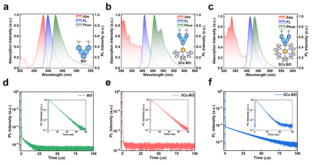A research team led by Prof. CUI Linsong from the University of Science and Technology of China (USTC), in collaboration with other researchers from the University of Cambridge and Beijing Information Science and Technology University proposes a novel design in deep blue organic light-emitting diode (OLED) which realizes a series of highly efficient luminescent compounds closely aligned with the BT.2020 blue light standard. The study was published in Advanced Materials.
OLED technology, characterized by its outstanding features, finds widespread application in smartphone screens. Luminescent materials play a pivotal role in OLED devices, influencing their efficiency, color purity, and lifespan. The quest for blue light materials is particularly vital as they not only provide essential blue light for display and illumination but also facilitate the generation of red and green light.
The current aim in display technology is to attain the BT.2020 ultra-high definition (UHD) color gamut standard, specifying standard color coordinates (CIE) for blue light as (0.131, 0.046) to meet the demands of UHD 4K/8K displays. This poses fresh challenges in blue light-emitting material design.
Researchers introduced an innovative strategy by incorporating multiple carbazole donor groups into the multiple resonance (MR) type electron acceptor units. The design not only conferred narrow-band short-range charge transfer excited states to the blue light molecules but also reduced the energy level difference between the molecule’s singlet and triplet states.

Steady state and transient emission spectra of deep blue light thermally activated delayed fluorescence molecules (Image by CUI et al.)
The efficacy of this design was further confirmed through theoretical calculations, demonstrating the characteristics of short-range charge transfer excited states for MR-type electron acceptor units and the formation of long-range charge transfer excited states. Structural relaxation in the excited state was effectively suppressed by the short-range charge transfer excited state, achieving narrow-band emission of deep blue light.
Meanwhile, researchers reduced the energy level difference between the molecule’s singlet and triplet states through the long-range charge transfer excited state, enhancing spin-orbit coupling and significantly increasing the molecule’s reverse intersystem crossing rate.
Moreover, the steric hindrance effects induced by the introduction of multiple carbazole donor groups effectively prevented the aggregation of MR acceptor units, allowing the molecule to maintain narrow-band emission of deep blue light.
OLED devices based on the 5Cz-BO molecule achieved a maximum external quantum efficiency of 22.8% and a CIE value of (0.163, 0.046), closely matching the current BT.2020 blue light standard. Furthermore, the high reverse intersystem crossing rate of 5Cz-BO enabled its use as a sensitizer, resulting in a maximum external quantum efficiency of 33.1% for sensitized devices.
The study is poised to overcome the bottleneck in achieving optimal color purity and efficiency for deep blue OLED devices, crucial for future UHD 4K/8K display technologies.
paper link: https://onlinelibrary.wiley.com/doi/epdf/10.1002/adma.202313602
(Written by LI Rui, edited by HUANG Rui, USTC News Center)